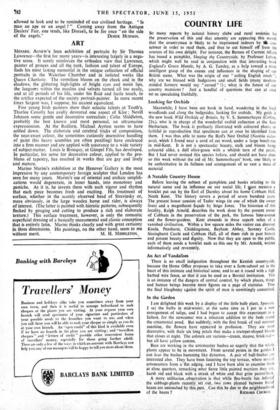ART MESSRS. AGNEW'S loan oxhibition of portraits by Sir Thomas
Lawrence—the first for many years—is interesting largely in a nega-
tive sense. It surely reinforces the orthodox view that Lawrence, painter of princes and all the rank, fashion and talent of Europe, finds his most lasting memorial in the unique collection of official portraits in the Waterloo Chamber and in isolated works like Queen Charlotte. The vermilion bloom on the cheek and in the shadows, the glittering high-lights of ,bright eyes and moist lips, the languors within the muslins and velvets turned all too easily, and at all periods of his life, under his fluid and facile touch, to the artifice expected of the society portrait-painter. In more recent times Sargent was, I suppose, his nearest equivalent.
Five young Irish painters show their eclectic talents at Tooth's. Thurloe Conolly has avidly devoured one aspect of Klee ; Nevill Johnson some gentle and decorative surrealism Colin Middleton, probably the best known and most personal, an ultramarine expressionism. At the Redfern, Michael Ayrton seems to have settled down. The elaborate and cerebral tricks of composition, the near-sweet colour, the sometimes curiously insensitive handling of paint (his heavy stumbles are often puzzling) have coalesced into a firm manner and are applied with assurance to a wide variety of subject-matter. Louis le Brocquy, at Gimpel Fils, has developed. In particular, his sense for decorative colour, applied to the pro- blems of tapestry, has resulted in works that are gay and lively and mature. Marino Marini's exhibition at the Hanover `Gallery is the most impressive by any contemporary foreign sculptor that London has seen for many years. Marini's use of oriental and archaic simplifi- cations would degenerate, in lesser hands, into monotony and pastiche. As it is, he invests them with such vigour and rhythm that each piece becomes fresh and exciting. His treatment of surface, whether in the acutely observed head of Stravinsky or, more obviously, in the large wooden horse and rider, is always of interest. (The latter is painted with hieratic patterns, subsequently flecked by gouging and cutting to produce a rich and elaborate texture.) This surface treatment, however, is only the romantic superficial dressing of a basically monumental and classic conception that is entirely latin. Marini thinks clearly and with great certainty in three dimensions. His paintings, on the other hand, seem to me


































 Previous page
Previous page